
I’m a believer in using decent windshields whenever you can: if you can manage a blimp then use it. My rig placing two omni mics end-to-end in a blimp as an alternative to, say, an AB pair in Baby Ball Gags on a stereo bar is very much following that approach: it also has the merit of being more portable and easier to set up in the field. And my previous tests on windshields confirmed my approach: even in light wind a Classic softie, for example, performed worse than a full blimp. And with more compact blimps, such as the smaller Nanoshields, it isn’t the case that you have to stick a small omni, cardioid or hypercardioid mic in a large windshield designed for shotgun mics. Sometimes, however, its necessary or possible to adopt something smaller than a full blimp. Examples include discreet recording of urban ambiences with a couple of small mics clipped to, or poking out from a bag; an almost still day; where you simply have no room to transport a blimp or two; tiny mics that are hard to rig in a blimp; or where you want to try some mic configuration that doesn’t lend itself so well to a full blimp (e.g. ORTF when you don’t have a dedicated ORTF blimp, or are using longer mics; or tying mics to either side of a tree – ‘tree ears’). I have a couple of options for such scenarios: a pair of Rycote Baby Ball Gags with furry covers, and a pair of the much cheaper and smaller Rode WS8 (furry slip-on windshields). I was intrigued, however, by reading very positive reviews of the cheap Movo windshields, especially the WSTT50 for small SDC mics such as the Line Audio CM4, so I bought one for the princely sum of £9.95 thinking it could be a better performing alternative to the similarly-sized Rode WS8 for those occasions when I do require the smallest and lightest windshield other than a foam. The Movo windshields, with their use of ballistic nylon, look very much like copies of the Rycote Super-Softies, but the WSTT50 at least has the merit of having no Rycote equivalent: it is about half the length of the smallest Rycote Super-Softie and, therefore, an attractive proposition for small mics – ironically such as those made by Rycote themselves!
These tests, therefore, are even more limited than those of my larger windshields. They are far from a comprehensive comparison of all, or even many, small windshields, but, nonetheless, may be of use to someone else out there: I hope so.
When using windshields care needs to be taken to ensure optimum fit. With the Baby Ball Gag it is self-evident, but with small push-on windshields the useful function of a small air gap is in front of the mic is usually beneficial. The following wav files each comprise three short clips separated by silence: first is the windshield pushed fully on the mic; second is the windshield pulled back to create a 10mm air gap in front of the mic; and third is the windshield pulled back to create a 20mm air gap in front of the mic. All other variables remained unchanged. The wind source is a fan, and the mics used were Rycote CA-08 cardioids.
In both cases there is, as expected, a substantial benefit of leaving an air gap in front of the mic. With the Movo WSTT50 this was slightly better at 10mm than at 20mm (about 2dB difference), and with the Rode WS8 the reverse: given that the latter was not very secure when pulled back so far, I have gone for a 10mm gap for both windshields in tests below.
First up, I took the windshields into the garden in very light wind, using omni mics (Rycote OM-08). Both windshields performed reasonably well, although it was evident that there was a little more wind noise with the Movo WSTT50. I had higher hopes for this and was surprised, so I set up the two windscreens over a fan indoors to examine the difference with more significant and consistent wind, and without the distraction of ambience (passing cars etc.). An initial test with Rode NT55 omni mics confirmed that there was significantly more low-frequency rumble with the Movo WSTT50 as evident by comparing the two wav files:
Swapping out the NT55 omni capsules for cardioid capsules produced more wind noise, as would be expected, and the increased low-frequency wind noise with the Movo WSTT50 is all the more evident:
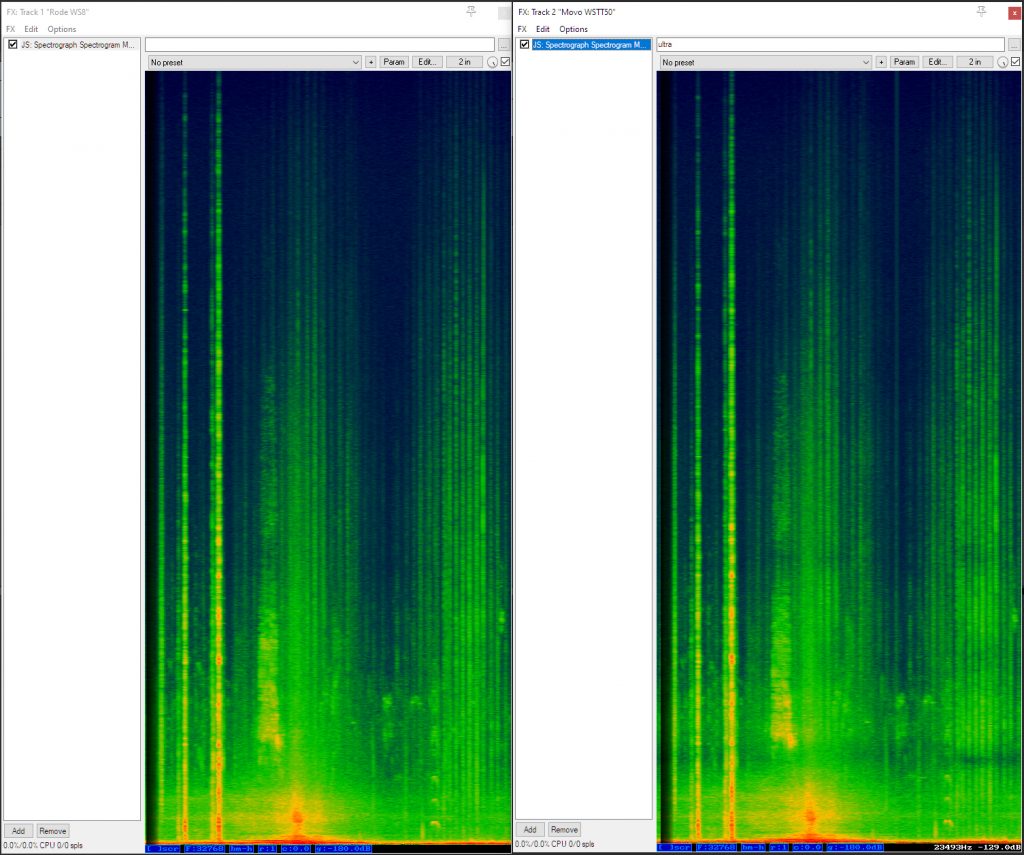
Back in the garden I noted that there didn’t seem to be any significant audible or, with a spectogram (see above), visible difference between the Rode WS8 and the Movo WSTT50 in terms of high-frequency loss. I was surprised, however, that the (increased) wind noise from the Movo seemed to be extending into higher frequencies than the noise from the WS8. It’s easy to get such things wrong and with the WS8 producing less overall wind noise anyway, it could have all been in my head. So, to explore this more carefully, again I moved inside and this time rigged two cardioid Rycote CA-08 mics on a short stereo bar (turned vertically so the mics were one above the other, about 200mm apart) fixed to the end of a boom pole. Fast boom swings, then, provided a means of just hearing the sound of wind on the windshields, without the effect of wind on the environment or the distraction of ambient garden and street noise, or, of using a fan, any mechanical noise.
Here are the wav files with a few forward-only swings with the Rode WS8 and the Movo WSTT50:
The results are revealing: as you would expect, a very fast boom swing with the WS8 produces a significant amount of low frequency noise, peaking around 25Hz and falling away quickly to around 100Hz; the WSTT50 has the same low-frequency noise (albeit more of it), and, confirming my impression from field use, a lot more above, extending up towards 400Hz.
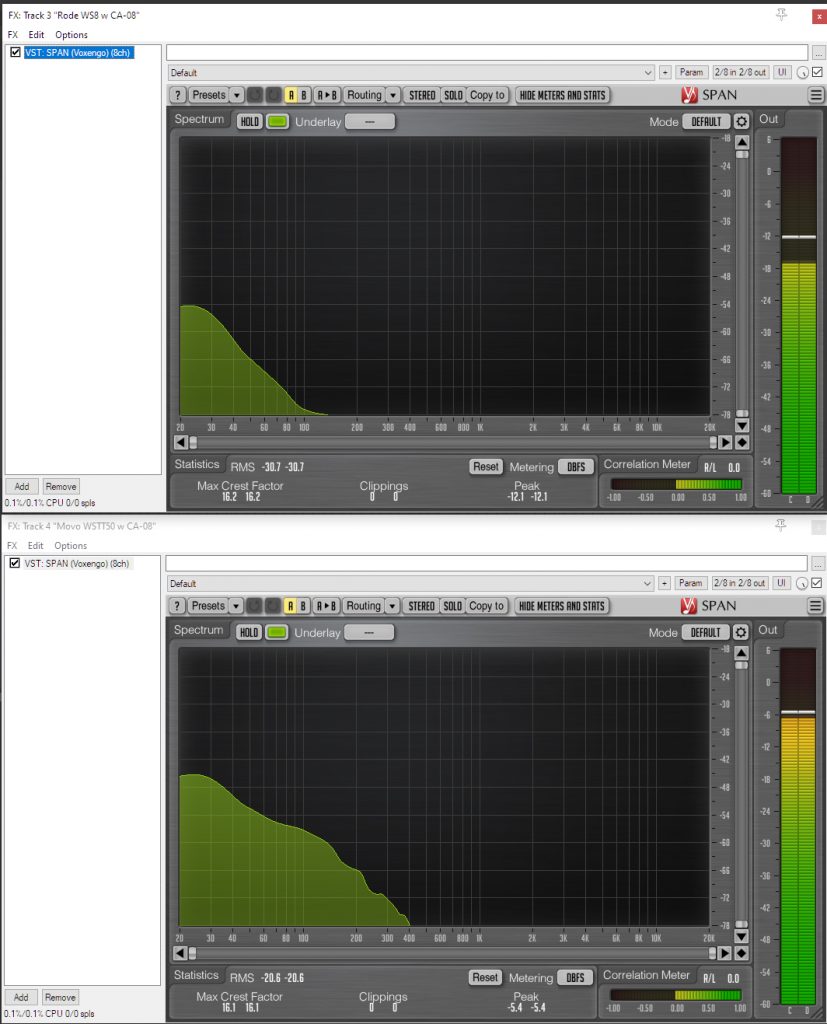
Making the same test with the WS8 and the Rycote Baby Ball Gag showed two things: first, the WS8 out-performed the Ball Gag when the latter was bare (perhaps not surprisingly as the plastic mesh sphere presents a lot of scope for wind noise generation) and, second, that the Baby Ball Gag with its fur on significantly outperforms the WS8.
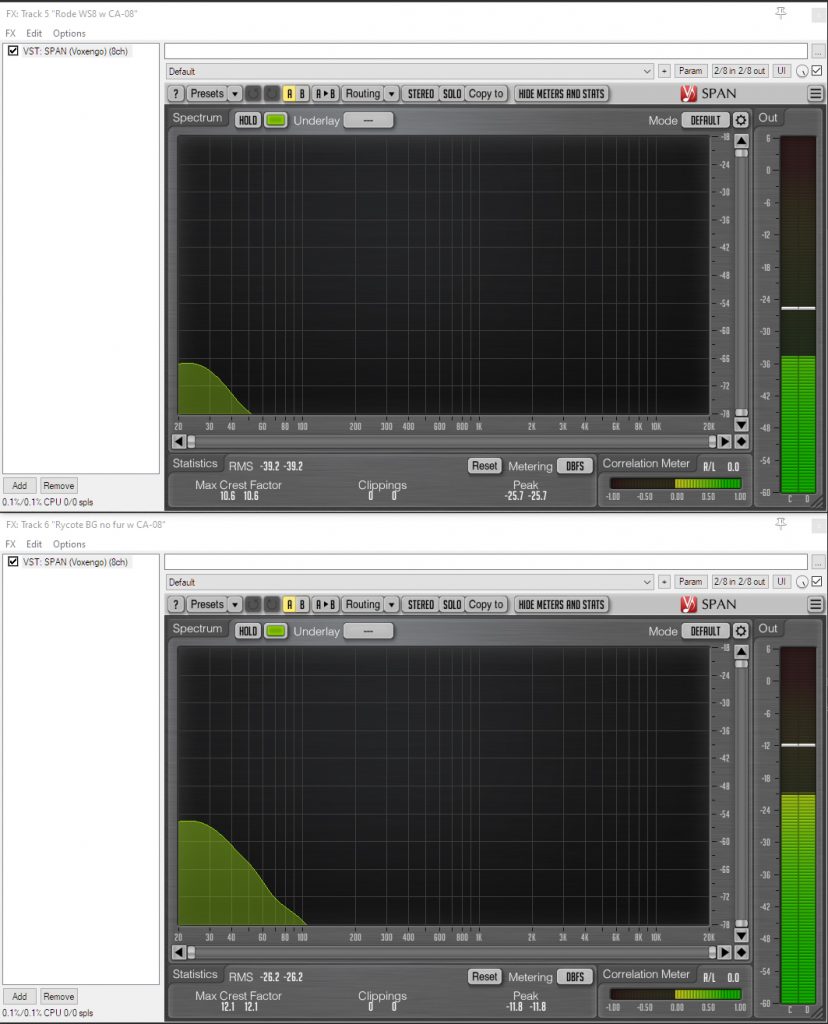
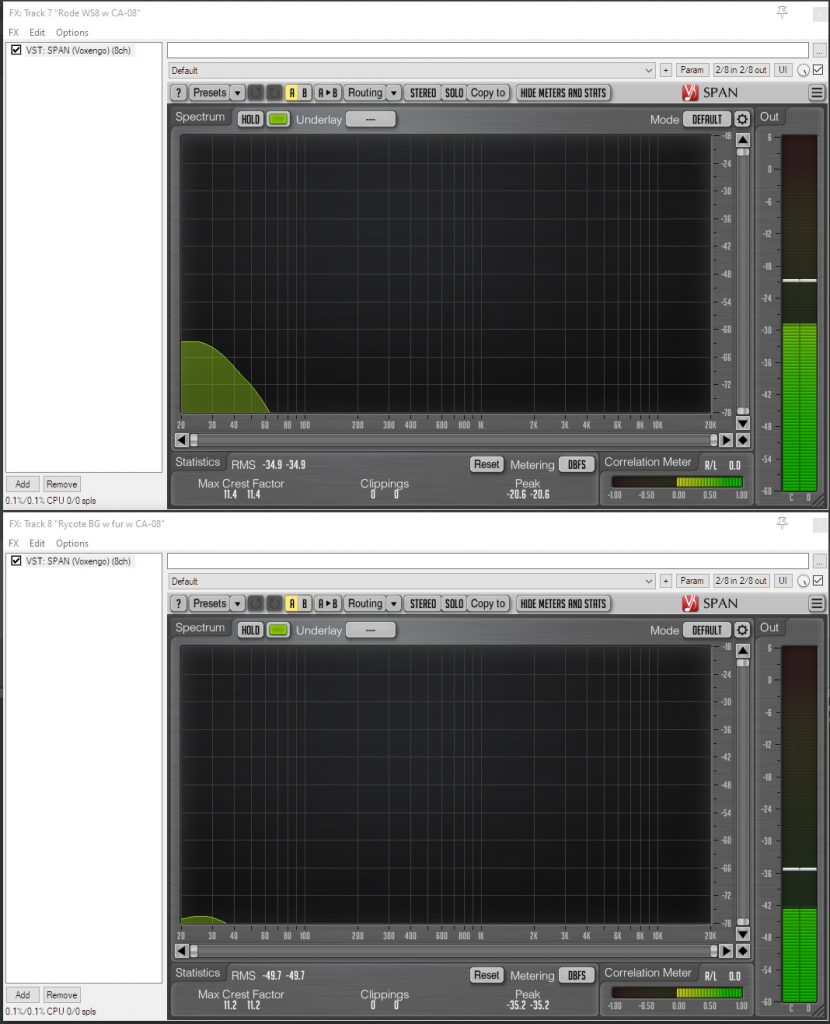
When I did the initial tests there were only light winds, and these then died away almost entirely for the best part of a week: unusual in February in Norfolk. But a week later a brisk and gusty wind returned, providing a good opportunity to check whether the Movo windshield was unfairly tested by very light winds, or the winds created by a fan and boom swings. So I went back out into the garden with a pair of omni mics (Rycote OM-08) on a stereo bar on a low stand as in my first test, and here are short clips of the results:
Again there is a clear difference between the two windshields, with the Rode WS8 handling the gusty and turbulent wind much better than the Movo WSTT50. And here is a visual expression of that difference:
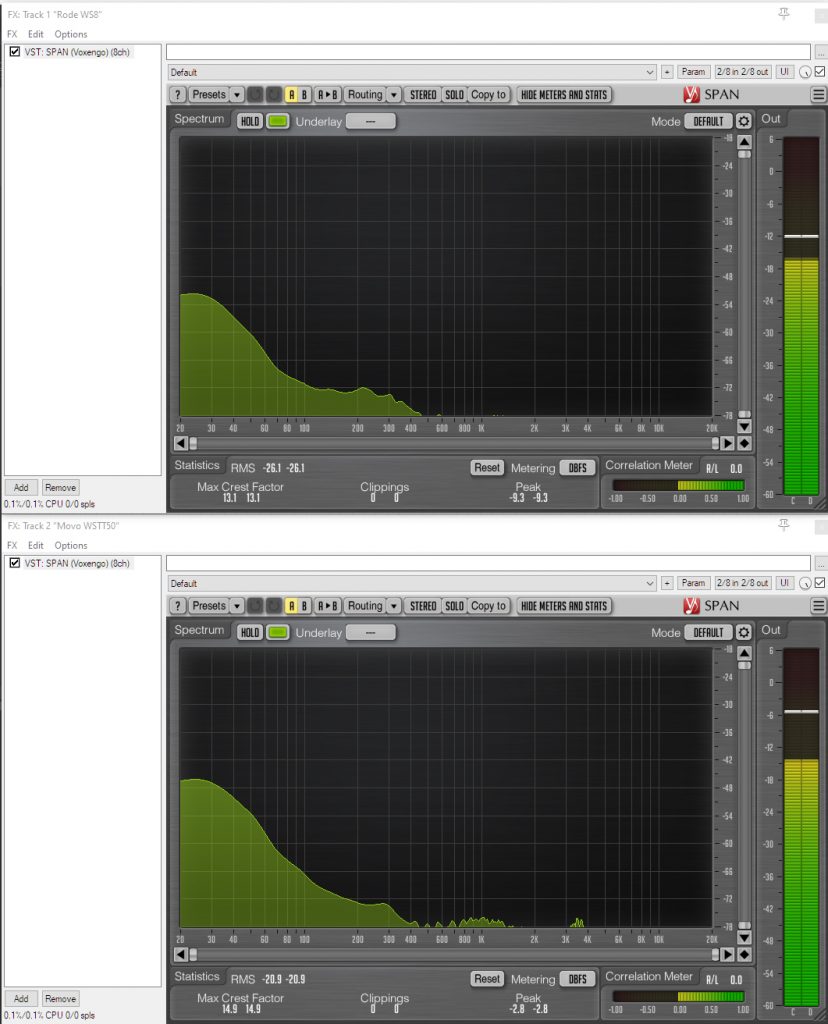
For the sake of completeness, I also compared both the Rode WS8 and the Movo WSTT50 to the Rycote Baby Ball Gag (with its fur on) again: the latter hugely outperformed the Movo, and, as expected, was a bit better than the WS8 too. Here are the sound files comparing the WS8 and the Baby Ball Gag:
Conclusions
There’s nothing very radical for me to conclude here in relation to my Rode WS8 and Rycote Baby Ball Gag windshields: the latter with its fur on outperforms the former in terms of wind noise reduction. What was surprising, given some on-line positive reviews, was that the Movo WSTT50 falls so short of the Rode WS8, in a range of situations and conditions, and with a range of different mics. Well, perhaps not such a surprise in that Rode is a more established microphone manufacturer, and its full blimp is not at all a bad performer. Having done these tests, I can’t say I have any further use for the Movo WSTT50 (and am glad I didn’t buy a pair of them!), but, at the price of a couple of pints of beer it was worth a test. Whether others find a use for them, or have had more luck with a different model, is another matter: but if wanting small and cheap, I’d recommend the few extra pounds for the WS8 (c.£23); if having a bit more to spend, perhaps consider the Baby Ball Gags with fur windjammers. But, whatever you use (and there are many other smaller slip-on windshields for SDCs), it might well be worth doing some comparative testing before using in earnest!
